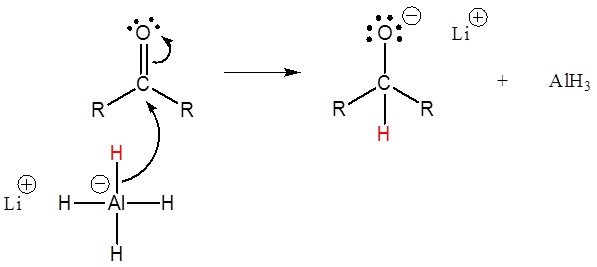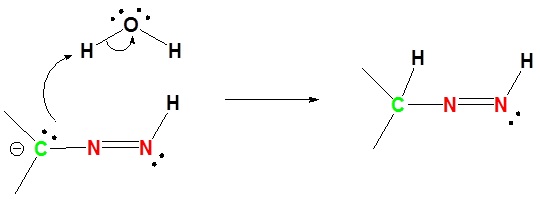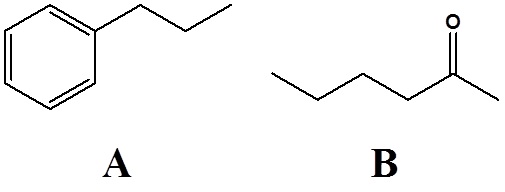Reduction of Aldehydes and Ketones
This page looks at the reduction of aldehydes and ketones by two similar reducing agents - lithium tetrahydridoaluminate(III) (also known as lithium aluminium hydride) and sodium tetrahydridoborate(III) (sodium borohydride).
The reducing agents
Despite the fearsome names, the structures of the two reducing agents are very simple. In each case, there are four hydrogens ("tetrahydido") around either aluminium or boron in a negative ion (shown by the "ate" ending). The "(III)" shows the oxidation state of the aluminium or boron, and is often left out because these elements only ever show the +3 oxidation state in their compounds.
The formulae of the two compounds are LiAlH4 and NaBH4. Their structures are:

In each of the negative ions, one of the bonds is a co-ordinate covalent (dative covalent) bond using the lone pair on a hydride ion (H-) to form a bond with an empty orbital on the aluminium or boron.
The reduction of an aldehyde
You get exactly the same organic product whether you use lithium tetrahydridoaluminate or sodium tetrahydridoborate. For example, with ethanal you get ethanol:

Notice that this is a simplified equation - perfectly acceptable to UK A level examiners. [H] means "hydrogen from a reducing agent". In general terms, reduction of an aldehyde leads to a primary alcohol.
The reduction of a ketone
Again the product is the same whichever of the two reducing agents you use. For example, with propanone you get propan-2-ol:

Reduction of a ketone leads to a secondary alcohol.
Using lithium tetrahydridoaluminate (lithium aluminium hydride)
Lithium tetrahydridoaluminate is much more reactive than sodium tetrahydridoborate. It reacts violently with water and alcohols, and so any reaction must exclude these common solvents. The reactions are usually carried out in solution in a carefully dried ether such as ethoxyethane (diethyl ether). The reaction happens at room temperature, and takes place in two separate stages.
In the first stage, a salt is formed containing a complex aluminium ion. The following equations show what happens if you start with a general aldehyde or ketone. R and R' can be any combination of hydrogen or alkyl groups.

The product is then treated with a dilute acid (such as dilute sulfuric acid or dilute hydrochloric acid) to release the alcohol from the complex ion.

The alcohol formed can be recovered from the mixture by fractional distillation.
Using sodium tetrahydridoborate (sodium borohydride)
Sodium tetrahydridoborate is a more gentle (and therefore safer) reagent than lithium tetrahydridoaluminate. It can be used in solution in alcohols or even solution in water - provided the solution is alkaline. Solid sodium tetrahydridoborate is added to a solution of the aldehyde or ketone in an alcohol such as methanol, ethanol or propan-2-ol. Depending on which recipe you read, it is either heated under reflux or left for some time around room temperature. This almost certainly varies depending on the nature of the aldehyde or ketone.
At the end of this time, a complex similar to the previous one is formed.

In the second stage of the reaction, water is added and the mixture is boiled to release the alcohol from the complex.

Again, the alcohol formed can be recovered from the mixture by fractional distillation.
Reduction of Carbonyls to Alcohols Using Metal Hydrides
The most common sources of the hydride Nucleophile are lithium aluminum hydride (LiAlH4) and sodium borohydride (NaBH4). Note! The hydride anion is not present during this reaction; rather, these reagents serve as a source of hydride due to the presence of a polar metal-hydrogen bond. Because aluminum is less electronegative than boron, the Al-H bond in LiAlH4 is more polar, thereby, making LiAlH4 a stronger reducing agent.
Addition of a hydride anion (H:-) to an aldehyde or ketone gives an alkoxide anion, which on protonation yields the corresponding alcohol. Aldehydes produce 1º-alcohols and ketones produce 2º-alcohols.
In metal hydrides reductions the resulting alkoxide salts are insoluble and need to be hydrolyzed (with care) before the alcohol product can be isolated. In the sodium borohydride reduction the methanol solvent system achieves this hydrolysis automatically. In the lithium aluminum hydride reduction water is usually added in a second step. The lithium, sodium, boron and aluminum end up as soluble inorganic salts at the end of either reaction. Note! LiAlH4 and NaBH4 are both capable of reducing aldehydes and ketones to the corresponding alcohol.
| Example 1 |
|---|
Mechanism
This mechanism is for a LiAlH4 reduction. The mechanism for a NaBH4 reduction is the same except methanol is the proton source used in the second step.
1) Nucleopilic attack by the hydride anion

2) The alkoxide is protonated

Going from Reactants to Products Simplified
Properties of Hydride Sources
Two practical sources of hydride-like reactivity are the complex metal hydrides lithium aluminum hydride (LiAlH4) and sodium borohydride (NaBH4). These are both white (or near white) solids, which are prepared from lithium or sodium hydrides by reaction with aluminum or boron halides and esters. Lithium aluminum hydride is by far the most reactive of the two compounds, reacting violently with water, alcohols and other acidic groups with the evolution of hydrogen gas. The following table summarizes some important characteristics of these useful reagents.
Wolff-Kishner Reduction
Aldehydes and ketones can be converted to a hydrazine derivative by reaction with hydrazine. These "hydrazones" can be further converted to the corresponding alkane by reaction with base and heat. These two steps can be combined into one reaction called the Wolff-Kishner Reduction which represents a general method for converting aldehydes and ketones into alkanes. Typically a high boiling point solvent, such as ethylene glycol, is used to provide the high temperatures needed for this reaction to occur. Note! Nitrogen gas is produced as part of this reaction.
Reaction of Aldehydes or Ketones with Hydrazine Produces a Hydrazone

Reaction with a Base and Heat Converts a Hydrazone to an Alkane

Both Reactions Together Produces the Wolff-Kishner Reduction

Example

Mechanism of the Wolff-Kishner Reduction
1) Deprotonation of Nitrogen

2) Protonation of the Carbon

3) Deprotonation of Nitrogen

4) Protonation of Carbon

Problems
1) Please draw the products of the following reactions.

Answers
1)

Clemmensen Reduction
The reaction of aldehydes and ketones with zinc amalgam (Zn/Hg alloy) in concentrated hydrochloric acid, which reduces the aldehyde or ketone to a hydrocarbon, is called Clemmensen reduction.
Introduction
This alternative reduction involves heating a carbonyl compound with finely divided, amalgamated zinc in a hydroxylic solvent (often an aqueous mixture) containing a mineral acid such as HCl. The mercury alloyed with the zinc does not participate in the reaction, it serves only to provide a clean active metal surface.


Example

Possible mechanism
The mechanism of Clemmensen reduction is not fully understood; intermediacy of radicals are implicated. Clemmensen reduction is complementary to Wolff-Kishner reduction, which also converts aldehydes and ketones to hydrocarbons, in that the former is carried out in strongly acidic conditions and the latter in strongly basic conditions.

References
- Clemmensen, E. Ber. Dtsch. Chem. Ges. 1913, 46, 1837–1843.
- Clemmensen, E. Ber. Dtsch. Chem. Ges. 1914, 47, 51–63.
- Clemmensen, E. Ber. Dtsch. Chem. Ges. 1914, 47, 681–687.
No comments:
Post a Comment